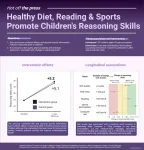How do children and adolescents evaluate and reason about acts of physical violence in the context of chronic violence that impacts their communities? Previous studies have used situations that correspond with a single act of interpersonal harm void of broader conditions of violence shaping the context in question. A new study released in Child Development examined how youth exposed to gangs known as maras (e.g., MS 13) in Honduras morally deliberate about conditions of gang violence compared with youth not exposed to gangs in Nicaragua, where there are very few maras and one of the lowest levels of violence in the region.
The findings showed youth from both exposure groups expressed a variety of concerns in their moral evaluations in either approval or disapproval of physical violence. For instance, some forms of violence were judged as having protective factors in conditions of insecurity, while others were endorsed out of fear.
The Society for Research in Child Development (SRCD) had the opportunity to chat with author Dr. Franklin Moreno from Rutgers, The State University of New Jersey about this important research and its implications.
SRCD: What contributed to your interest in pursuing this particular research?
Dr. Moreno: The conditions of communty violence and gangs shaped my personal life growing up, and the topic of violence has been a long-standing academic interest of mine. Regarding Central America, my maternal family lived the political violence and later civil war in El Salvador. My mother fled the violence and immigrated to the United States. These personal connections further motivated my interests. I’ve worked on a number of projects with artists in El Salvador and across the Central American region, later conducting my master’s thesis research in El Salvador on collective trauma, post-war, and cultural policies and institutions. My child developmental research is informed by my personal and professional experiences and knowledge in the region.
Having learned more of the governmental policies and their consequences addressing gang violence in Central America over the years, I saw how particular psychological models of exposure to violence were being adopted to inform those policies, especially prevention efforts. One expectation motivating policy efforts was that children exposed to the violence accepted the violence in their moral beliefs. However, it seemed to me that such models didn’t account for the complexity of thinking by children and adolescents around the conditions of violence impacting their lives. Thus, I focused on specific conditions of violence associated with gangs that constrain community life from a social-domain approach to moral development. From this perspective, I examined the ways in which children and adolescents coordinated different concerns and concepts associated with the contexts of gang violence informing their moral judgments.
Another, broader factor, motiving my current research interests in the same communities in Honduras is knowing how the local conditions of violence in Central America are shaped and linked to transnational policies with other countries, such as the United States. Thus, we must approach such developmental science research in ways that attempts to account for, or at the very least, recognize such transnational realities.
SRCD: Describe your research questions.
Dr. Moreno: My research questions for this particular study, were the following:
How do 10-11 and 14-15-year-olds morally evaluate and reason about acts of physical violence in the context of chronic violence that impacts their community? That is, how do youth consider actual conditions impacting their own community to see which concerns and related concepts they coordinate in making their evaluations of the harm.
Are there differences in how children and adolescents exposed to gang violence morally evaluate and reason about acts of physical harm compared to children and adolescents not exposed to such chronic community violence?
Are there differences in moral evaluation and reasoning by age or gender?
SRCD: Please summarize your findings.
Dr. Moreno: Major findings include that youth from both exposure groups evaluated unprovoked acts of physical harm as wrong for moral reasons, especially given that youth in San Pedro Sula, Honduras have been exposed to chronic levels of community violence involving gangs. These results highlight how under general conditions, children and adolescents prioritize the well-being of others in judging acts of physical harm as wrong.
Other major findings were that judgments and justifications about physical harm by both exposure groups varied by gang context. In some contexts, gang-exposed youth were more likely to endorse harming a rival gang member, whereas no differences were found by exposure group in other contexts. Contrary to expectations, few differences were found by age group, suggesting that older children and adolescents considered similar concerns and concepts when evaluating the situations involving gangs. And few differences were found by gender.
SRCD: What are some implications of your research?
Dr. Moreno: Youth from both exposure groups expressed a variety of concerns in their moral evaluations in either approval or disapproval of physical violence. For instance, some forms of violence were judged as having protective factors in conditions of insecurity, while others were endorsed out of fear. This suggests that improving conditions of community-level violence requires practitioners and developmental researchers to better understand the actual conditions of insecurity and security children are growing up in. Relatedly, prevention programs would benefit from not generally assuming that children and adolescents automatically and passively morally accept the conditions of violence they are exposed to.
A second implication is that studies on children’s and adolescents’ moral development would benefit by differentiating between different types of violence occurring at the community-level, involving different community members, in understanding how youth evaluate and make sense of the violence impacting their lives.
SRCD: What are any limitations in your research?
Dr. Moreno: Some limitations of this study include not having used an exposure to violence (ETV) assessment from which to measure in some manner the extent of each participant’s exposure to specific types of violent behavior in their community. However, widely used measures omit important types of violence that have real consequences to community life, safety, and functioning, such as the maintenance of territory borders by rival gangs or the wide-spread practice of extortion. The sample size limits the generalizability of the findings and possibly impacts non-significant effects in the study due to lack of power. However, the design of the study did include a comparison between one group exposed to mara-related violence and another not exposed that was matched by gender, age, SES, and certain cultural factors such as language. Lastly, the types of gang violence examined in this study are specific to community conditions in Honduras compared to Nicaragua; however, youth in the neighboring countries of Guatemala and El Salvador also face similar conditions by the same gangs (MS-13 and Barrio 18).
SRCD: Do you have recommendations on future work in this area?
Dr. Moreno: Violence as a social phenomenon is complex and varies in functions and forms, over time. Therefore, child developmental research on exposure to violence must account for the local contexts and dynamics of the violence children and adolescents are grappling with. In addition, community violence should not be treated as a general phenomenon. For instance, in current research with colleagues, we are examining youth emotional security development associated with conditions of community violence and safety that are co-structured by gangs, law enforcement agencies (not just one), family, and other community members.
SRCD: If you could offer one quote or takeaway about the research, what might that be?
Dr. Moreno: A major take away is that children and adolescents from both exposure groups coordinated a number of moral and social concepts and concerns in their moral judgments about acts of physical harm associated with gang violence. This study offers evidence that moral judgments and reasoning are forms of knowledge in which children and adolescents make sense of the violence impacting their lives and their communities.
###
This work was funded by the Society for the Psychological Study of Social Issues and the University of California, Berkeley.
Summarized from Child Development, “Moral Reasoning About Gang Violence in Context: A Comparative Study with Children and Adolescents Exposed to Maras in Honduras and Not Exposed in Nicaragua” by Moreno, F. (Rutgers, The State University of New Jersey). Copyright 2023 The Society for Research in Child Development, Inc. All rights reserved.
END





